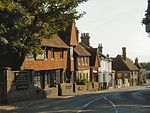Pevensey Levels

Pevensey Levels is a 3,603.2-hectare (8,904-acre) biological Site of Special Scientific Interest between Bexhill-on-Sea and Hailsham in East Sussex. It is a Nature Conservation Review site, Grade I, a Ramsar site and a Special Area of Conservation. An area of 183.5 hectares (453 acres) is a national nature reserve and an area of 150 hectares (370 acres) is a nature reserve called Pevensey Marshes which is managed by the Sussex Wildlife Trust.This is a large area of wetland grazing meadows intersected by a network of ditches. It has many nationally rare invertebrates. It may be the best site in Britain for freshwater mollusc fauna, including the endangered shining ram's-horn snail. It also has one nationally rare and several nationally scarce aquatic plants and it is of national importance for lapwing, with more than 1% of the British population.
Excerpt from the Wikipedia article Pevensey Levels (License: CC BY-SA 3.0, Authors, Images).Pevensey Levels
Wealden Pevensey
Geographical coordinates (GPS) Address Nearby Places Show on map
Geographical coordinates (GPS)
| Latitude | Longitude |
|---|---|
| N 50.844 ° | E 0.338 ° |
Address
Pevensey
Wealden, Pevensey
England, United Kingdom
Open on Google Maps










